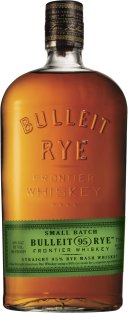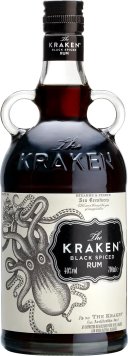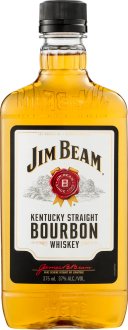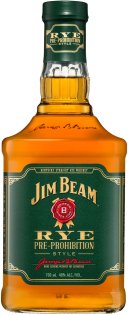Bulleit Rye Whiskey
Bulleit Rye offers inviting aromas of cherry, sweet cedar and spice, which lead to a smooth, balanced palate entry. Soft fruit notes appear first, but soon give way to sweet and spicy flavors of maple, vanilla, oak, and toffee, which contrast with touches of cinnamon and black pepper. Notes of caramel and dried fruit linger through the medium dry finish. Mature enough to drink neat.
The Kraken Black Spiced Rum
The Kraken Rum is an imported rum from the Caribbean blended with 13 secret spices . Named for the sea beast of myth and legend, The KRAKEN RUM is a strong, rich, black and smooth rum that's aged in barrels for 24 months to impart classic dark rum flavours of cinnamon, ginger and clove.
Nelson County Blended Bourbon & Cola Can
Mellow and smooth, this 12% Kentucky Bourbon & Cola delivers a strong but gentle Bourbon flavour with a sweet vanilla taste and a rich finish.
Jim Beam White Label Bourbon Whiskey
Originated in the 1780s by Jacob Beam, a Kentucky farmer, who operated a grain mill and ground grist for locals - a portion of which was always reserved for the families private use - to make whisky. It was in 1795 the Jacob finally began commercial production, however it was not under the Beam Label. Consistency of style has been maintained by using the same yeast cultures for over 60 years, derived from an original culture made by Jim Beam himself on his back porch. Beam Bourbon is the product of six generations of distillers with only one enforced break in production between 1920 and 1933 when prohibition was introduced to the U.S. It was following prohibition, (during which time the distillery had been shut and sold to the U.S. government) that the bourbon was named "Jim Beam" after the head of the Beam family. To drink Beam then is to taste something of its American heritage. White Label is aged for four years and appreciated for it's pleasant sweet/sour and mellow, nutty character, making it one of the biggest selling Bourbons globally. 37% alc./vol.
Jim Beam Rye Whiskey
With a distinctive spicy flavour and long, soft finish, Jim Beam Rye is an interesting change for those who want to broaden their Bourbon horizons.
Woodford Reserve Kentucky Straight Rye Whiskey
Made in the traditional style of Kentucky Ryes, Woodford Reserve Kentucky Straight Rye Whiskey delivers bold flavours of pepper and tobacco with a long fruit and sweetly spiced finish. Grain the first of the Five Sources is exactly sourced to produce the defined taste we're looking for in every bottle of Woodford Reserve. Our mash bill contains 53 percent rye, resulting in a liquid with pronounced spice notes that are sweetly hinted with fruit before a long finish.
Journeyman Distillery Last Feather Rye Organic Whiskey
A wheat-heavy, grain-to-bottle rye whiskey that beautifully balances the spiciness of rye and sweetness of wheat, Last Feather Rye is one of Journeymans best-known and most highly-decorated products. Single-distillation from 60% organic rye / 40% organic wheat.TASTING NOTES;Ripe banana on the note, spice and pepper of rye really well balanced with sweetness of wheat, fruit notes, clean and dry, mint notes - easy drinking.
Jack Daniels Bonded Whiskey
Jack Daniels Bonded is Jacks time-honored recipe of 80% corn, 12% malted barley, and 8% rye, but distilled to the standards of the Bottled-In-Bond act (1897), meaning this whiskey is from one distilling season, at 100 proof (50% ALC/VOL), and is matured for a minimum of 4 years at our federally bonded warehouses. Barrels were hand selected for their unique and particular characteristics of deeper colour, flavor, and aroma, which bring a darker, richer, and more oak-forward character to Jack Daniels Bonded. It is a big, bold Tennessee Whiskey with layered notes of caramel, rich oak, and spice giving way to a pleasantly lingering finish.
Buffalo Trace Bourbon Whiskey
For over 200 years, Buffalo Trace Distillery has been defined by a dedication to one craft: making fine American whiskey. By honouring tradition and embracing change, it has earned its place of leadership among the legendary spirits producers of the world and is now recognised as the World’s Most Awarded Distillery. The venture produces a wide range of whiskeys using three different mash bills: one light rye, one heavy rye and a third flavoured with wheat. They've developed different products by aging those three mash bills to meet various grades and price points. At Buffalo Trace, that translates into at least fifteen labels: W. L. Weller, Eagle Rare, George T.Stagg and Old Rip Van Winkle (amongst others), and that's not counting many reserve and limited-release variants. While the mash bills contribute to the flavour, the more significant differentiation among brands takes place in century-old warehouses. Constructed of massive wood beams and covered by a brick shell, these structures allow the alternating cooling and warming of Kentucky's four distinct seasons to mature the bourbon by nature's timetable. Steam pumped throughout the warehouses during the extreme cold of winter compensates for the dramatic drops in temperature and gives the whiskey additional cycles in and out of the wood. This is said to make for a more balanced bourbon as the liquid is able to take additional advantage of the natural sugars occurring in the charred barrels. The distillery was the first to use this method of aging in 1859 and has been doing so ever since. The warehouses were built in the 1900s and represent diverse architectural styles. Consequently, their designs and location on the property contribute to the significant differences in the whiskey coming from each. Certain floors within a given warehouse produce better whiskey than others do. For example, the fourth and fifth floors of Warehouse C and the fourth through sixth floors of Warehouses I and K produce the company's best. It's these locations which have been reserved for the maturation of Buffalo Trace. The brand itself was born only relatively recently. In 1999, visitors to the newly named and renovated distillery asked, “Why isn’t there a bourbon called ‘Buffalo Trace?" In response, Elmer T. Lee ventured into the best floors in the best warehouses to find some of the finest barrels that really matched up with his views on what a full-bodied, robust Kentucky straight bourbon whiskey should taste like. The result was what consumers enjoy today , batched from no more than 40 barrels at a time. There are two ABV variants on offer - one at 45% and this lower proof 40% bottling. The flavour profiles are pretty much identical, but as you would expect, less alcohol means a little less concentration. That said, the difference isn't huge, and what you miss out on is made up for in dollar savings. The style moves away from macho Bourbon, aligning with the feminine elegance of whiskeys like Evan Williams Single Barrel. As an affordable, middle-tier offering, it's also deceptively complex. The rye is evident but balanced by softer, sweeter notes like vanilla wafers, toasted sponge cake, cherry chocolate and just plain old, high-quality American oak. This expression doesn't boast super length, but it is incredibly easy to drink. Our preference is uncut (too much water makes it a little 'peachy' and the more nuanced notes are lost). An ice cube and a comfortable chair by the barbeque is all you need to complete the picture.
George Dickel No.8 Tennessee Whiskey
Presently run by Master Distiller, John Lunn, who continues the hands on process as set forth by George Dickel and again by Ralph Dupps, Dickel whiskey is produced from a mash of corn, barley and rye. The grains are finely ground at the distillery before being cooked. They are then cooled in mash tubs by pure spring water from Cascade Spring, located about one-half mile up the road from the distillery. Fermentation is begun using a proprietory yeast, followed by a double distillation - firstly in a column still, then in a pot-still. The process of charcoal mellowing then occurs, which defines the difference between Tennessee whiskey and bourbon whiskey. In this process, the double-distilled whiskey is filtered through sugar maple charcoal. Dickel's mellowing process is unique in that it is chilled prior to the filtration process. This process of chilling the whiskey resulted from George discovering that the batches of whiskey he tasted during the winter were noticeably smoother than those he tasted during warmer weather. He called this process chill mellowing. The first step in the mellowing process is selecting and cutting sugar maple trees. Trees are cut in the winter months when the sugar maple's rich flavour is stored in the trunk of the tree. The trunks are allowed to season and cut into strips. These strips are hand-stacked and set ablaze in the open air. This process allows the smoke's impurities to escape from the resulting hard charcoal. The hard maple charcoal is crushed by hand and packed into one of six mellowing vats located at the distillery. About ten feet of charcoal is packed into each vat. Two virgin wool blankets are placed on the top and bottom of the charcoal. The top blanket ensures that the newly chilled whiskey uniformly reaches into the vat, while the bottom blanket keeps the charcoal from escaping as the whiskey leaves the vat. The entire chill charcoal mellowing process takes seven to ten days to complete, and though this extra process is time consuming and expensive, the distillery believes the end result speaks for itself. The whisky is finally aged in new, charred American white oak barrels. Full barrels are aged just up the hill from the distillery in the industry's only single-storied iron-clad warehouses. Dickel No.8 received a silver medal in 2005 at the San Francisco World Spirits Competition. More recently it was lauded with the prestigious Gold Medal. Tasting notes: Bright topaz. Aromas of toasted toasted marshmallow, sweet corn and vanilla bean as well as hints of rye freshness. A youthful but nicely rounded whiskey with attractive corn, toasty oak, cocoa and peppermint notes leading into a gently spicy finish. Value buy. 40% Alc./Vol.

















